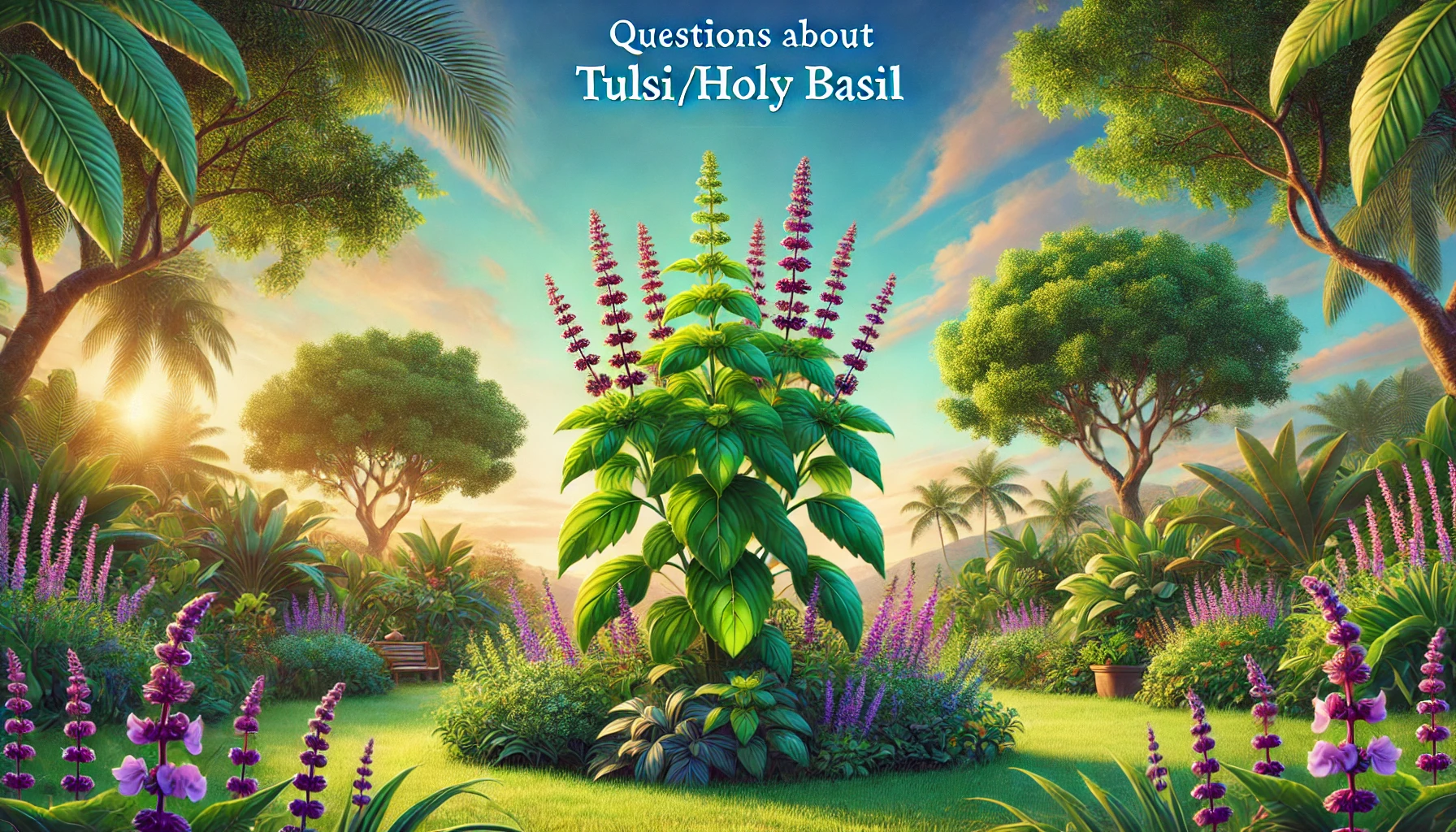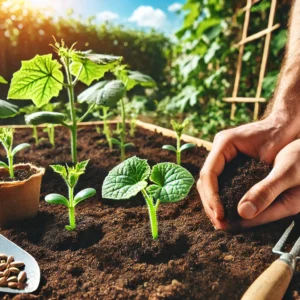1. What is Tulsi?
Tulsi, also known as Holy Basil, is a sacred herb in Hinduism and is widely grown for its medicinal properties and aromatic qualities.
2. What are the types of Tulsi?
There are mainly three types of Tulsi: Rama Tulsi (green leaves), Krishna Tulsi (purple leaves), and Vana Tulsi (wild variety).
3. How do I plant Tulsi seeds?
Plant Tulsi seeds in well-drained soil, keeping them about 1/4 inch deep. Water gently and keep the soil moist until the seeds germinate.
4. Can Tulsi be grown indoors?
Yes, Tulsi can be grown indoors in pots as long as it receives enough sunlight, ideally 6-8 hours of direct sunlight daily.
5. What type of soil is best for Tulsi?
Tulsi prefers well-drained, fertile soil with a pH between 6.0 and 7.5.
6. How often should I water Tulsi?
Water Tulsi regularly, keeping the soil consistently moist but not waterlogged. Reduce watering in winter.
7. How much sunlight does Tulsi need?
Tulsi needs 6-8 hours of direct sunlight per day for optimal growth.
8. Can I grow Tulsi from cuttings?
Yes, Tulsi can be propagated from cuttings. Cut a healthy stem, remove the lower leaves, and place it in water or directly in soil to root.
9. What are the benefits of growing Tulsi?
Tulsi has numerous benefits including medicinal uses, air purification, and religious significance.
10. How do I fertilize Tulsi?
Use organic fertilizers such as compost or well-rotted manure. A balanced NPK (nitrogen, phosphorus, potassium) fertilizer can also be applied.
11. What pests commonly affect Tulsi?
Common pests include aphids, whiteflies, and spider mites.
12. How do I control pests on Tulsi plants?
Use neem oil spray or insecticidal soap to control pests. Regularly check for pest infestations and remove affected parts.
13. What diseases affect Tulsi?
Tulsi can be affected by fungal diseases like powdery mildew and root rot.
14. How do I prevent diseases in Tulsi?
Ensure proper air circulation, avoid waterlogging, and use well-drained soil to prevent diseases.
15. When should I harvest Tulsi leaves?
Harvest Tulsi leaves once the plant is well-established, usually after 60-70 days. Pick the leaves in the morning after dew has dried.
16. How do I store Tulsi leaves?
Dry the leaves in a shaded, well-ventilated area and store them in an airtight container away from direct sunlight.
17. Can Tulsi be grown hydroponically?
Yes, Tulsi can be grown hydroponically with appropriate nutrient solutions and light.
18. How tall does a Tulsi plant grow?
Tulsi plants typically grow to a height of 1-2 feet, but some varieties can grow taller.
19. Is Tulsi a perennial or annual plant?
Tulsi is a perennial plant in tropical climates and an annual in cooler climates.
20. How do I prune Tulsi?
Prune Tulsi regularly by pinching off the tips of the branches to encourage bushier growth and prevent flowering.
21. Can Tulsi be grown in pots?
Yes, Tulsi can be grown in pots. Choose a pot with good drainage and at least 12 inches in diameter.
22. What is the best time to plant Tulsi seeds?
The best time to plant Tulsi seeds is in the spring after the last frost has passed.
23. How do I transplant Tulsi seedlings?
Transplant Tulsi seedlings when they have at least 4-6 true leaves. Carefully dig them out and replant in a larger pot or garden bed.
24. Can I grow Tulsi in winter?
Tulsi can be grown indoors during winter, provided it receives enough light and warmth.
25. What are the medicinal uses of Tulsi?
Tulsi is used to treat respiratory issues, digestive problems, inflammation, and as an immune booster.
26. How do I make Tulsi tea?
To make Tulsi tea, steep fresh or dried Tulsi leaves in hot water for 5-10 minutes. Strain and enjoy.
27. How do I dry Tulsi leaves?
Dry Tulsi leaves by spreading them out in a single layer in a shaded, well-ventilated area until they are crisp.
28. Can Tulsi be grown in shade?
Tulsi prefers full sun but can tolerate partial shade with at least 4-6 hours of sunlight daily.
29. How do I propagate Tulsi from seeds?
Sow Tulsi seeds in a seed tray or pot, cover lightly with soil, and water gently. Keep the soil moist until germination.
30. How long do Tulsi seeds take to germinate?
Tulsi seeds typically take 7-14 days to germinate.
31. What are the signs of overwatering in Tulsi?
Signs of overwatering include yellowing leaves, wilting, and root rot.
32. What is the best way to mulch Tulsi plants?
Mulch around Tulsi plants with organic materials like straw, leaves, or compost to retain moisture and suppress weeds.
33. How often should I fertilize Tulsi?
Fertilize Tulsi every 4-6 weeks during the growing season with a balanced fertilizer.
34. Can Tulsi be grown in sandy soil?
Tulsi can grow in sandy soil if it is enriched with organic matter to improve fertility and water retention.
35. What is the ideal temperature for growing Tulsi?
The ideal temperature for growing Tulsi is between 70-95°F (21-35°C).
36. Can Tulsi be grown from store-bought seeds?
Yes, Tulsi can be grown from store-bought seeds. Ensure they are from a reputable source.
37. How do I protect Tulsi from frost?
Bring potted Tulsi plants indoors during frost, or cover garden plants with a frost cloth.
38. How do I improve the flavor of Tulsi leaves?
Grow Tulsi in full sun and avoid over-fertilizing to enhance the flavor of the leaves.
39. What companion plants grow well with Tulsi?
Companion plants for Tulsi include tomatoes, peppers, and marigolds, which can help deter pests.
40. How do I make a Tulsi plant bushier?
Pinch off the growing tips of the plant regularly to encourage branching and bushier growth.
41. Why are my Tulsi leaves turning yellow?
Yellow leaves can indicate overwatering, nutrient deficiencies, or pest infestations.
42. How can I use Tulsi in cooking?
Tulsi can be used fresh or dried in teas, soups, salads, and as a seasoning for various dishes.
43. Can Tulsi help purify indoor air?
Yes, Tulsi is known to help purify indoor air by absorbing pollutants and releasing oxygen.
44. How long does a Tulsi plant live?
In tropical climates, Tulsi can live for several years. In temperate regions, it may live for one growing season unless brought indoors during winter.
45. Why is my Tulsi plant not flowering?
Tulsi may not flower if it lacks sufficient sunlight, nutrients, or if it is pruned too frequently.
46. Can I grow Tulsi on my balcony?
Yes, Tulsi can be grown on a balcony if it receives adequate sunlight and is protected from strong winds.
47. How do I deal with Tulsi root rot?
To deal with root rot, improve soil drainage, reduce watering, and remove affected parts of the plant.
48. What are the spiritual benefits of Tulsi?
Tulsi is considered sacred in Hinduism and is believed to bring peace, prosperity, and spiritual purification.
49. How do I attract pollinators to my Tulsi plant?
Allow some Tulsi plants to flower to attract bees and other pollinators to your garden.
50. Can Tulsi be used in skincare?
Yes, Tulsi has antimicrobial and anti-inflammatory properties that make it beneficial for skincare, such as in face masks and cleansers.
51. What is the Pot size for Holy Basil Plant?
Choose a pot that is at least 12 inches in diameter and 10-12 inches deep to accommodate the plant’s root system and provide ample room for growth.



